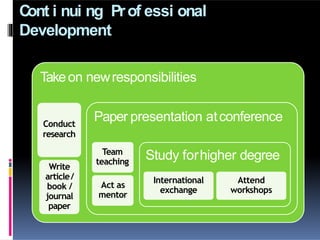Continuing education in nursing 2
- 2. History of Continuing Education in Nursing “Let usnever consider ourselvesasfinished nurses….. Wemust belearning all our lives” -FlorenceNightingale Theidea of continuing education in nursing is asold asorganized nursing, but the concept of lifelong learning for the practitioner hasdeveloped slowly Thehistory of continuing education in nursing has shown that educational institutions generally have beenslow to acceptresponsibility for assisting the practitioner who wishes to add to her nursing knowledge andskill
- 3. Need Rapidtechnological advancesrelated to knowledge explosion havegreatly altered the practice of nursing Thegap between scientific knowledge and its application grows wider eachyear asaresult of multiple influences Elimination of certain illnesses,particularly the communicable diseases New drugs to cure someillnessesandalter the courseof many Surgeriesarebeing performed successfullyin areasthat would not havebeenattempted 10-20yearsago Organ transplants are no more anovelty Complexand intricate machinery canextend lives All these advancesrequire more highly skilled nursing carein a great variety ofsettings Continuing education is anacceptedway of life
- 4. Nurses and Continuing Education Are Nursesexception? In fact we laggedbehind Certain exceptional nurses have alwaysbeen self-directed learners
- 5. Once a Nurse, al ways a Nurse? “some continuation training in service for nurses would promote the well-being of the nation” Major reason for continuing education in nursing: the improvement in professional practice Life-long learning in nursing relates not only to professional practice but also to the development of the person asan individual and asaresponsible citizen Charles JuddAJN(1928)
- 6. Definitions “Continuing education is any extension of opportunities for reading, study and training to young persons and adults following their completion of or withdrawal from full-time school and collegeprograms” Dictionary ofEducation
- 7. Adult Education ThetermsContinuing Education andAdult Education are oftenused interchangeably
- 8. Continuing Nursing Education “Educational activities primarily designed to keepregistered nursesabreast of their particular field of interest and do not lead to any formal advanced standing in the profession” NursingThesaurus of the International Nursing Index
- 9. In-service Education “Planned instructional or training program provided by an employing agency in the employment setting and is designed to increasecompetencein aspecific area” In-service Education is one aspect of continuing education, but the terms arenot interchangeable
- 10. Cont i nui ng Prof essi onal Development Takeon newresponsibilities Conduct research Write article/ book / journal paper Paper presentation atconference Team teaching Act as mentor Study forhigher degree International exchange Attend workshops
- 11. Types Orientation to introduce new recruits to the basic aspectsof the job sothat they canperform their job effectively Continuing education for the improvement of knowledge, skills andattitudes Management skills and leadershiptraining Staff development program is directed toward expanding to the fullest all the potentials of an individual Individual Interest PromotionPrograms FutureOriented Programs to prepare learnersfor the futureactivities
- 12. The Planning Formula What isto bedone? Why is it necessary How is itto bedone? Where is it to bedone? When is it to bedone? Whoshould do thejob?
- 14. Analysis Analyze needs Goals Priorities Resources Constraints and Alternate deliverysystems Determine scopeand sequenceof training program (by task and job analysis)
- 15. Design Emphasizes what will be taught Determine trainingapproach Develop learningobjectives Performance measures Training programspecifications
- 16. Development Emphasizes on how the content will be taught Develop curriculumguide Lessonplan Supportive teachingaids Revisematerial
- 17. Implementation Implement trainingplan Conducttraining Formative evaluation Document trainingresults
- 18. Evaluation Conduct summativeevaluation Analyze collectedinformation Initiate correctiveaction
- 19. Benefits of Continuing Nursing Education New / Improved • Knowledge andSkills • Attitudinal Change Institution • Better Performance • Quality PatientCare Personal • Increased JobSatisfaction • High Motivation
- 20. Content Areas • NursingProcess • IntravenousTherapy • Communication • Ethics General Programs • Maternity • Pediatrics • Surgical • Orthopedics Hospital Specific Programs • CVPCare • NeonatalCPR • Ventilator • Dialysis Area Specific Programs
- 21. Learning Learning continues through out life and is called “lifelonglearning” From “womb” to“tomb” Learning makeslife easier,fuller longer and more enjoyable Learning has practicalpurpose
- 22. In- service Educator Public Relations Educational Preparation with emphasis onAdult Education The Continuing Educator asa Continuing Learner ClinicalKnowledge andSkill Working withAdults BroadKnowledge Base Concern for People Determination Self-confidence Zest for life Innate curiosity Love for adventure Desire to search the unknown Flexibility Creativity Resourcefulness






















